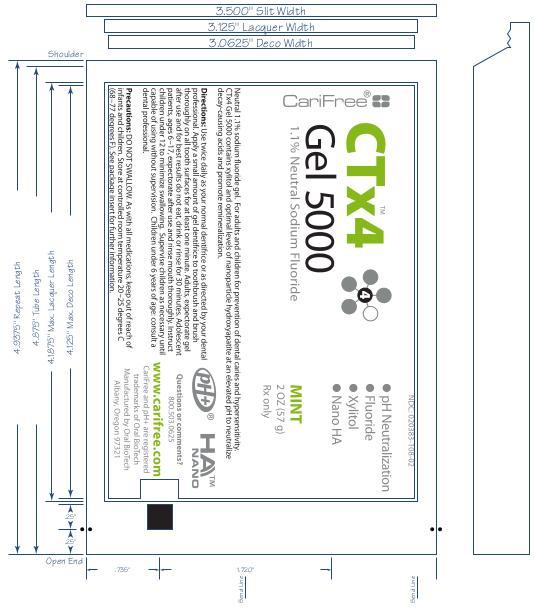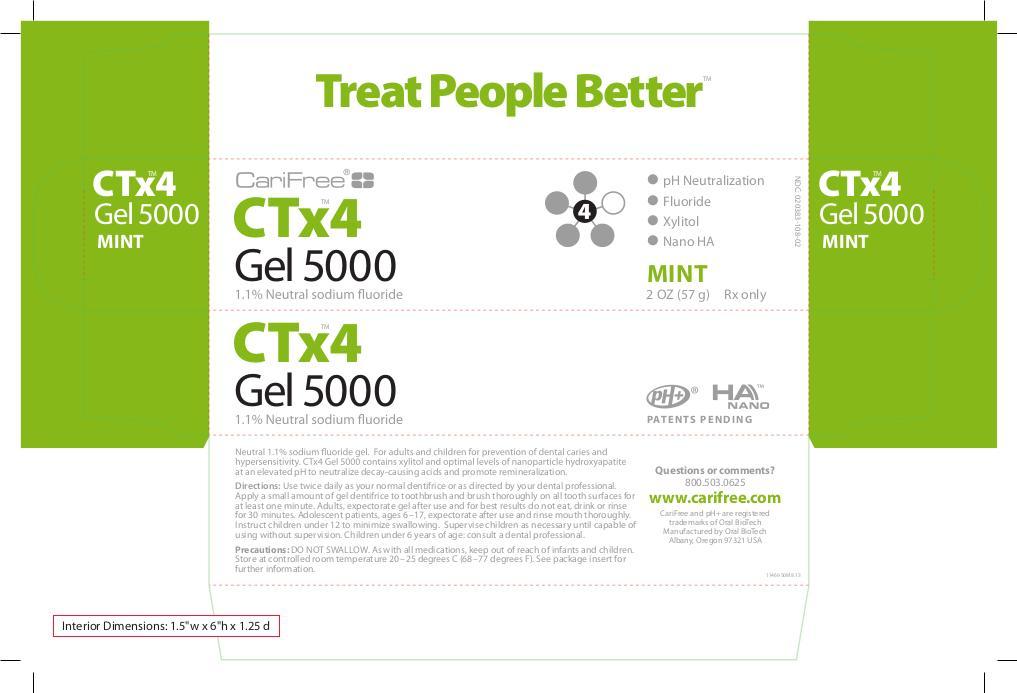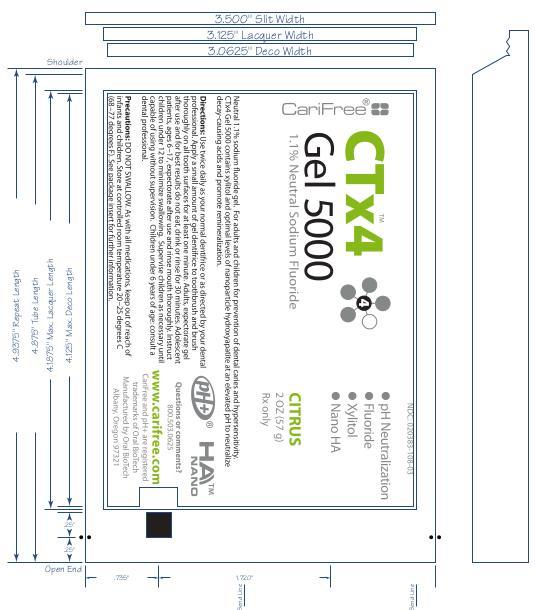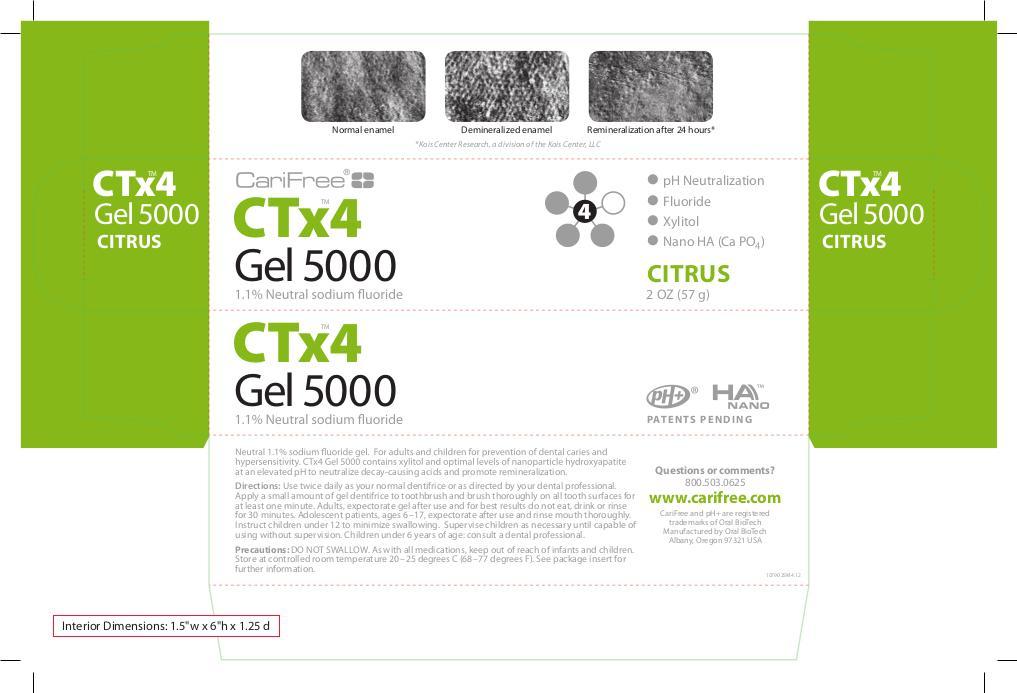CTX4 GEL 5000 MINT- sodium fluoride gel, dentifrice CTX4 GEL 5000 CITRUS- sodium fluoride gel, dentifrice
CTx4 Gel 5000 by
Drug Labeling and Warnings
CTx4 Gel 5000 by is a Prescription medication manufactured, distributed, or labeled by DENTAL ALLIANCE HOLDINGS LLC. Drug facts, warnings, and ingredients follow.
Drug Details [pdf]
- Description:
- Active Ingredient:
-
Other Ingredients:
Glycerin, Hydrated Silica, Hydrogenated Starch Hydrolysate (HSH), Hydroxyapatite, Hydroxyethyl Cellulose, Natural Flavors (Mint only), Natural and Artificial Flavors (Citrus only), Polysorbate 20, Potassium Sorbate, Saccharin, Sodium Benzoate, Sodium Bicarbonate, Sodium Hydroxide, Sodium Lauryl Sulfate, Water, Xylitol
- Clinical Pharmacology:
-
Indications and Use:
A dental caries preventive; for once daily self-applied topical use. It is well established that a 1.1% sodium fluoride is safe and extraordinarily effective as a caries preventive when applied frequently with mouthpiece applicators.1-4 CariFree CTx4 Gel 5000 brand of 1.1% sodium fluoride toothpaste in a squeeze tube is easily applied onto a toothbrush as well as a mouthpiece tray. This prescription dental gel should be used once daily following use of a regular toothpaste unless otherwise instructed by your dental professional. May be used in areas where drinking water is fluoridated since topical fluoride cannot produce fluorosis. (See Warnings for exception)
- Contraindications:
-
Warnings:
Prolonged daily ingestion may result in various degrees of dental fluorosis in pediatric patients under age 6 years, especially if water fluoridation exceeds 0.6 ppm. Use in pediatric patients under age 6 years requires special supervision to prevent repeated swallowing of gel. Read directions carefully before using. Keep out of reach of infants and children.
- Precautions:
-
Carcinogenesis, Mutagenesis, Impairment of Fertility:
In a study conducted in rodents, no carcinogenesis was found in male and female mice and female rats treated with fluoride at dose levels ranging from 4.1 to 9.1 mg/kg of body weight. Equivocal evidence of carcinogenesis was reported in male rats treated with 2.5 and 4.1 mg/kg of body weight. In a second study, no carcinogenesis was observed in rats, males or females, treated with fluoride up to 11.3 mg/kg of body weight. Epidemiological data provided no credible evidence for an association between fluoride, either naturally occurring or added to drinking water, and risk of human cancer.
Fluoride is not mutagenic in standard bacterial systems. It has been shows that fluoride ion has potential to induce chromosome aberrations in cultured human and rodent cells at doses much higher than those to which humans are exposed. In vivo data are conflicting. Some studies report chromosome damage in rodents, while other studies using similar protocols report negative results.
Potential adverse reproductive effects of fluoride exposure in humans has not been adequately evaluated. Adverse effects on reproduction were reported for rats, mice, fox, and cattle exposed to 100 ppm or greater concentrations of fluoride in their diet or drinking water. Other studies conducted in rats demonstrated that lower concentrations of fluoride (5 mg/kg of body weight) did not result in impaired fertility and reproductive capabilities. -
Pregnancy:
Pregnancy Category B. It has been shown that fluoride crosses the placenta of rats, but only 0.01% of the amount administered is incorporated in fetal tissue. Animal studies (rats, mice, rabbits) have shown that fluoride is not teratogen. Maternal exposure to 12.2 mg fluoride/kg of body weight (rats) or 13.1 mg/kg of body weight (rabbits) did not affect the litter size or fetal weight and did not increase the frequency of skeletal or visceral malformations. There are no adequate and well-controlled studies in pregnant women. However, epidemiological studies conducted in areas with high levels of naturally fluoridated water showed no increase in birth defects. Heavy exposure to fluoride during in utero development may result in skeletal fluorosis, which becomes evident in childhood.
-
Nursing Mothers:
It is not known if fluoride is excreted in human milk. However, many drugs are excreted in milk, and caution should be exercised when products containing fluoride are administered to a nursing woman. Reduce milk production was reported in farm-raised fox when the animals were fed a diet containing a high concentration of fluoride (98-137 mg/kg of body weight). No adverse effects on parturition, lactation, or offspring were seen in rats administered fluoride up to 5 mg/kg of body weight.
-
Pediatric Use:
The use of CariFree CTx4 Gel 5000 in pediatric age group 6 to 16 years as a caries preventive is supported by pioneering clinical studies with 1.1% sodium fluoride gels in mouth trays in students age 11 to 14 years conducted by Englander et al.2-4 Safety and effectiveness in pediatric patients below the age of 6 years have not been established. Please refer to Contraindications and Warnings sections.
- Adverse Reactions:
-
Overdosage:
Accidental ingestion of large amounts of fluoride may result in acute burning in the mouth and sore tongue. Nauseau, vomiting, and diarrhea may occur soon after ingestion (within 30 minutes) and are accompanied by salivation, hematemesis, and epigastric cramping abdominal pain. These symptoms may persist for 24 hours. If less than 5 mg fluoride/kg body weight (ie, less than 2.3 mg fluoride/lb body weight) have been ingested, give calcium (eg, milk) orally to relieve gastrointestinal symptoms and observe for a few hours. If more than 5 mg fluoride/kg body weight (ie, more than 2.3 mg fluoride/lb body weight) have been ingested, induce vomiting, give orally soluble calcium (eg, milk, 5% calcium gluconate or calcium lactate solution) and immediately seek medical assistance. For accidental ingestion of more than 15 mg fluoride/kg of body weight (ie, more than 6.9 mg fluoride/lb body weight), induce vomiting and admit immediately to a hospital facility.
A treatment dose (a thin ribbon) of CariFree CTx4 Gel 5000 contains 2.5 mg fluoride. A 2 oz tube contains 284 mg fluoride. -
Dosage and Administration:
Follow these instructions unless otherwise instructed by your dental professional:
1. After brushing with toothpaste, adults and pediatric patients 6 years of age and older, apply a thin ribbon of gel to the teeth with a toothbrush for at least one minute, preferably at bedtime.
2. Adult patients, expectorate gel after use. For best results, do not eat, drink or rinse for 30 minutes. Pediatric patients, age 6-16, expectorate gel after use and rinse mouth thoroughly. - How Supplied:
- Storage:
-
References:
1. American Dental Association, Accepted Dental Therapeutics, Ed 40, Chicago (1984): 405-407.
2. HR Englander et al, “Clinical Anticaries Effect of Repeated Topical Sodium Fluoride Applications by Mouthpieces,” JADA, 75 (1967): 638-644.
3. HR Englander et al, “Residual Anticaries Effect of Repeated Topical Sodium Fluoride Applications by Mouthpieces,” JADA, 78 (1969): 783-787.
4. HR Englader et al, “Incremental Rates of Dental Caries After Repeated Topical Sodium Fluoride
Applications in Children with Lifelong Consumption of Fluoridated Water,” JADA, 82 (1971): 354-358. -
CTx4 Gel 5000 Mint and Citrus enclosure and carton labels:

-----------------------------------------------------------------------------------------------------------------------------------------------------------------------------------------------------------

------------------------------------------------------------------------------------------------------------------------------------------------------------------------------------------------------------

-----------------------------------------------------------------------------------------------------------------------------------------------------------------------------------------------------------

-
INGREDIENTS AND APPEARANCE
CTX4 GEL 5000 MINT
sodium fluoride gel, dentifriceProduct Information Product Type HUMAN PRESCRIPTION DRUG Item Code (Source) NDC: 61578-205 Route of Administration DENTAL Active Ingredient/Active Moiety Ingredient Name Basis of Strength Strength SODIUM FLUORIDE (UNII: 8ZYQ1474W7) (FLUORIDE ION - UNII:Q80VPU408O) FLUORIDE ION 5000 ug in 1 g Inactive Ingredients Ingredient Name Strength GLYCERIN (UNII: PDC6A3C0OX) HYDRATED SILICA (UNII: Y6O7T4G8P9) MALTITOL (UNII: D65DG142WK) TRIBASIC CALCIUM PHOSPHATE (UNII: 91D9GV0Z28) HYDROXYETHYL CELLULOSE (3000 CPS AT 1%) (UNII: 7Q6P4JN1QT) MENTHOL (UNII: L7T10EIP3A) POLYSORBATE 20 (UNII: 7T1F30V5YH) POTASSIUM SORBATE (UNII: 1VPU26JZZ4) SACCHARIN (UNII: FST467XS7D) SODIUM BENZOATE (UNII: OJ245FE5EU) SODIUM BICARBONATE (UNII: 8MDF5V39QO) SODIUM HYDROXIDE (UNII: 55X04QC32I) SODIUM LAURYL SULFATE (UNII: 368GB5141J) WATER (UNII: 059QF0KO0R) XYLITOL (UNII: VCQ006KQ1E) Product Characteristics Color white (opaque) Score Shape Size Flavor MINT Imprint Code Contains Packaging # Item Code Package Description Marketing Start Date Marketing End Date 1 NDC: 61578-205-01 56.699 g in 1 TUBE, WITH APPLICATOR Marketing Information Marketing Category Application Number or Monograph Citation Marketing Start Date Marketing End Date unapproved drug other 05/01/2012 CTX4 GEL 5000 CITRUS
sodium fluoride gel, dentifriceProduct Information Product Type HUMAN PRESCRIPTION DRUG Item Code (Source) NDC: 61578-206 Route of Administration DENTAL Active Ingredient/Active Moiety Ingredient Name Basis of Strength Strength SODIUM FLUORIDE (UNII: 8ZYQ1474W7) (FLUORIDE ION - UNII:Q80VPU408O) FLUORIDE ION 5000 ug in 1 g Inactive Ingredients Ingredient Name Strength GLYCERIN (UNII: PDC6A3C0OX) HYDRATED SILICA (UNII: Y6O7T4G8P9) MALTITOL (UNII: D65DG142WK) TRIBASIC CALCIUM PHOSPHATE (UNII: 91D9GV0Z28) HYDROXYETHYL CELLULOSE (3000 CPS AT 1%) (UNII: 7Q6P4JN1QT) POLYSORBATE 20 (UNII: 7T1F30V5YH) POTASSIUM SORBATE (UNII: 1VPU26JZZ4) SACCHARIN (UNII: FST467XS7D) SODIUM BENZOATE (UNII: OJ245FE5EU) SODIUM BICARBONATE (UNII: 8MDF5V39QO) SODIUM HYDROXIDE (UNII: 55X04QC32I) SODIUM LAURYL SULFATE (UNII: 368GB5141J) WATER (UNII: 059QF0KO0R) XYLITOL (UNII: VCQ006KQ1E) Product Characteristics Color white (opaque) Score Shape Size Flavor CITRUS Imprint Code Contains Packaging # Item Code Package Description Marketing Start Date Marketing End Date 1 NDC: 61578-206-01 56.699 g in 1 TUBE, WITH APPLICATOR Marketing Information Marketing Category Application Number or Monograph Citation Marketing Start Date Marketing End Date unapproved drug other 05/01/2012 Labeler - Oral BioTech (195544965) Registrant - Oral BioTech (195544965) Establishment Name Address ID/FEI Business Operations Oral BioTech 195544965 manufacture(61578-205, 61578-206) , label(61578-205, 61578-206) , pack(61578-205, 61578-206)
© 2025 FDA.report
This site is not affiliated with or endorsed by the FDA.